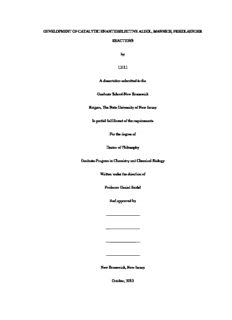
DEVELOPMENT OF CATALYTIC ENANTIOSELECTIVE ALDOL, MANNICH, FRIEDLAENDER ... PDF
Preview DEVELOPMENT OF CATALYTIC ENANTIOSELECTIVE ALDOL, MANNICH, FRIEDLAENDER ...
DEVELOPMENT OF CATALYTIC ENANTIOSELECTIVE ALDOL, MANNICH, FRIEDLAENDER REACTIONS by LE LI A dissertation submitted to the Graduate School-New Brunswick Rutgers, The State University of New Jersey In partial fulfillment of the requirements For the degree of Doctor of Philosophy Graduate Program in Chemistry and Chemical Biology Written under the direction of Professor Daniel Seidel And approved by __________________ __________________ __________________ __________________ New Brunswick, New Jersey October, 2010 ABSTRACT OF THE DISSERTATION DEVELOPMENT OF CATALYTIC ENANTIOSELECTIVE ALDOL, MANNICH, FRIEDLÄNDER REACTIONS By LE LI Dissertation Director: Professor Daniel Seidel In Chapter I, I introduce the explosive development of enantioselective organocatalysis. Selected significant landmarks in this area are reviewed and highlighted in this chapter. Chapter II focuses on the development of catalytic enantioselective aldol additions of (cid:1)- isothiocyanato imides to aldehydes and (cid:1)-ketoesters. Chapter III outlines the development of enantioselective Mannich reactions of (cid:1)- isothiocyanato imides with activated imines and the asymmetric synthesis of (cid:1), (cid:2)- diamino acid derivatives. In Chapter IV, the first catalytic enantioselective Friedländer condensation is described which provides access to quinolines and tacrines with remote stereogenic centers. ii (cid:1) ACKNOWLEDGEMENTS First of all, I would like to truly appreciate my advisor, Dr. Daniel Seidel, for his guidance and motivation in the last five years at Rutgers University. This thesis would not have been possible without him. In addition, I am very grateful for having an outstanding doctoral committee and wish to thank the rest of my committee members, Dr. Haiming Zhang, Dr. Kai Hultzsch, Dr. Lawrence Williams, and Dr. Xumu Zhang, for their generous support and helpful discussions. Also, I would like to thank Prof. Karsten Krogh-Jespersen and Dr. Thomas Emge for their technical support and beneficial suggestions in computation and crystallography. I thank all the members of the Seidel Group. In particular, I would like to thank Michael Haibach and Matthew Vecchione for their helpful suggestions during the preparation of this thesis. Moreover, I would like to thank a lot of friends in chemistry, in the department and outside. Finally, I cannot forget giving my sincere gratitude to my family. Their love and continuous support make everything easier. iii (cid:1) DEDICATION I dedicate this thesis to my beloved grandmother, parents and wife. Their love and continuous support always encourage me to move forward. iv (cid:1) Table of Contents Abstract of the dissertation.................................................................................................ii Acknowledgements............................................................................................................iii Dedication..........................................................................................................................iv List of figures.....................................................................................................................xi List of schemes.................................................................................................................xii List of tables.....................................................................................................................xiv Chapter 1 Introduction........................................................................................................1 1.1 Background...............................................................................................................1 1.1.1 History................................................................................................................1 1.1.2 Renaissance and Explosive Development..........................................................3 1.2 Major Branches of Organocatalysis..........................................................................4 1.2.1 Enamine Catalysis..............................................................................................4 1.2.2 Iminium Catalysis...............................................................................................6 1.2.3 Hydrogen Bond Catalysis...................................................................................8 1.2.4 Stronger Brønsted Acid Catalysis.....................................................................10 1.2.5 Phase Transfer Catalysis...................................................................................12 1.2.6 N-heterocyclic Carbenes as Organocatalysts...................................................14 1.2.7 Lewis Base Catalysis.......................................................................................15 v (cid:1) 1.2.8 Miscellaneous Types........................................................................................18 1.3 Objectives................................................................................................................19 References.....................................................................................................................21 Chapter 2 Catalytic Enantioselective Synthesis of (cid:2)-Hydroxy-(cid:1)-Amino Acid Derivatives ...........................................................................................................................................30 2.1 Background.............................................................................................................30 2.1.1 Significance of (cid:2)-Hydroxy-(cid:1)-Amino Acid Derivatives...................................30 2.2 Proposal and Objective............................................................................................33 2.3 Results and Discussions..........................................................................................33 2.3.1 General Considerations.....................................................................................33 2.3.2 Preliminary Investigation on Aldol Reactions of (cid:1)-Isocyano Acetates with Benzaldehydes...........................................................................................................33 2.3.3 Development of Organocatalyzed Aldol Reactions of (cid:1)-Isothiocyanato Imides and Esters with Aldehydes........................................................................................35 2.3.3.1 Reaction Development..................................................................................35 2.3.3.2 Scope of the Reactions..................................................................................39 2.3.3.3 Scale-up Synthesis of Protected (cid:2)-Hydroxy-(cid:1)-Amino Acid.........................41 2.3.3.4 Summary........................................................................................................41 2.3.4 Development of Organocatalyzed Aldol Reactions of (cid:1)-Isothiocyanato Imides and Esters with (cid:1)-Ketoesters.....................................................................................41 vi (cid:1) 2.3.4.1 Reaction Development..................................................................................41 2.3.4.2 Substrate Scope..............................................................................................45 2.3.4.3 Summary........................................................................................................46 2.3.5 Latest Progress in this Area..............................................................................46 2.4 Experimental Section..............................................................................................47 2.4.1 Preparation of Substrates and Precursors.........................................................47 2.4.2 Preparation of Catalysts....................................................................................50 2.4.3 General Procedure for the Catalytic Aldol Reaction Between 2.46 and Aldehyde....................................................................................................................51 2.4.4 General Procedure for Catalytic Aldol reaction between isothiocyanates and a- ketoesters...................................................................................................................52 2.4.5 Preparation Procedures for Racemic Samples..................................................52 2.4.6 Product Characterization Data..........................................................................53 2.4.7 Scale-up Preparation of 3-((4R,5S)-5-(4-fluoro-3-nitrophenyl)-2- thioxooxazolidine-4-carbonyl)-4,4-dimethyloxazolidin-2-one (2.51)......................74 References.....................................................................................................................76 Chapter 3 Catalytic Enantioselective Synthesis of (cid:1),(cid:2)-Diamino Acid Derivatives..........81 3.1 Background.............................................................................................................81 3.1.1 Significance of Chiral (cid:1),(cid:2)-Diamino Acid Derivatives.....................................81 3.1.2 Synthetic Methods for (cid:1),(cid:2)-Diamino Acid Derivatives.....................................82 vii (cid:1) 3.2 Proposal and Objective............................................................................................84 3.3 Results and Discussions..........................................................................................85 3.3.1 General Considerations.....................................................................................85 3.3.2 Reaction Development.....................................................................................86 3.3.3 Substrate Scope.................................................................................................89 3.3.4 Synthesis of a Chiral (cid:1),(cid:2)-Diamino Acid...........................................................91 3.3.5 Conclusion........................................................................................................92 3.3.6 Latest Development in this Area......................................................................92 3.4 Experimental Section..............................................................................................93 3.4.1 Preparation Procedures for Substrates and Catalysts.......................................93 3.4.2 General Procedure for the Catalytic Mannich Reaction Between Isothiocyanates and Imines........................................................................................93 3.4.3 General Procedure for the Conversion of Primary Products into Their Corresponding Ethyl Esters.......................................................................................93 3.4.4 Preparation Procedures for Racemic Samples..................................................94 3.4.5 Product Characterization Data..........................................................................94 3.4.6 Procedure for the Conversion of Products 3.36a Into Its Corresponding Diamino Acids.........................................................................................................122 References...................................................................................................................127 viii (cid:1) Chapter 4 Facile Access to Tetrahydroacridine Derivatives with Remote Stereogenic Centers: Catalytic Enantioselective Friedländer Condensations....................................131 4.1 Background...........................................................................................................131 4.1.1 Significance of Tetrahydroacridine Derivatives.............................................131 4.1.2 Synthetic Methods for Tacrine and Tetrahydroacridine Derivatives.............132 4.1.3 Enamine Catalysis as a Powerful Synthetic Tool...........................................133 4.2 Proposal and Objective..........................................................................................136 4.3 Results and Discussions........................................................................................137 4.3.1 General Considerations...................................................................................137 4.3.2 Evaluation of Catalysts...................................................................................138 4.3.3 Evaluation of Solvents....................................................................................142 4.3.4 Substrate Scope...............................................................................................144 4.3.5 Synthesis of a Chiral Non-Racemic Tacrine Analog......................................146 4.3.6 Computational Study......................................................................................148 4.3.7 Conclusion......................................................................................................150 4.4 Experimental Section............................................................................................150 4.4.1 Preparation Procedures for Catalysts, Cyclohexanones and Amino Aldehydes .................................................................................................................................150 4.4.2 General Procedure for Catalytic Enantioselective Friedländer Condensations .................................................................................................................................151 ix (cid:1) 4.4.3 Product Characterization Data........................................................................151 4.4.4 Synthesis of a Chiral Tacrine Analog.............................................................164 4.4.5 Computational Studies....................................................................................167 References...................................................................................................................185 Appendix: Selected HPLC Profiles and NMR Spectra...................................................194 Curriculum Vitae............................................................................................................469 x (cid:1)
Description: